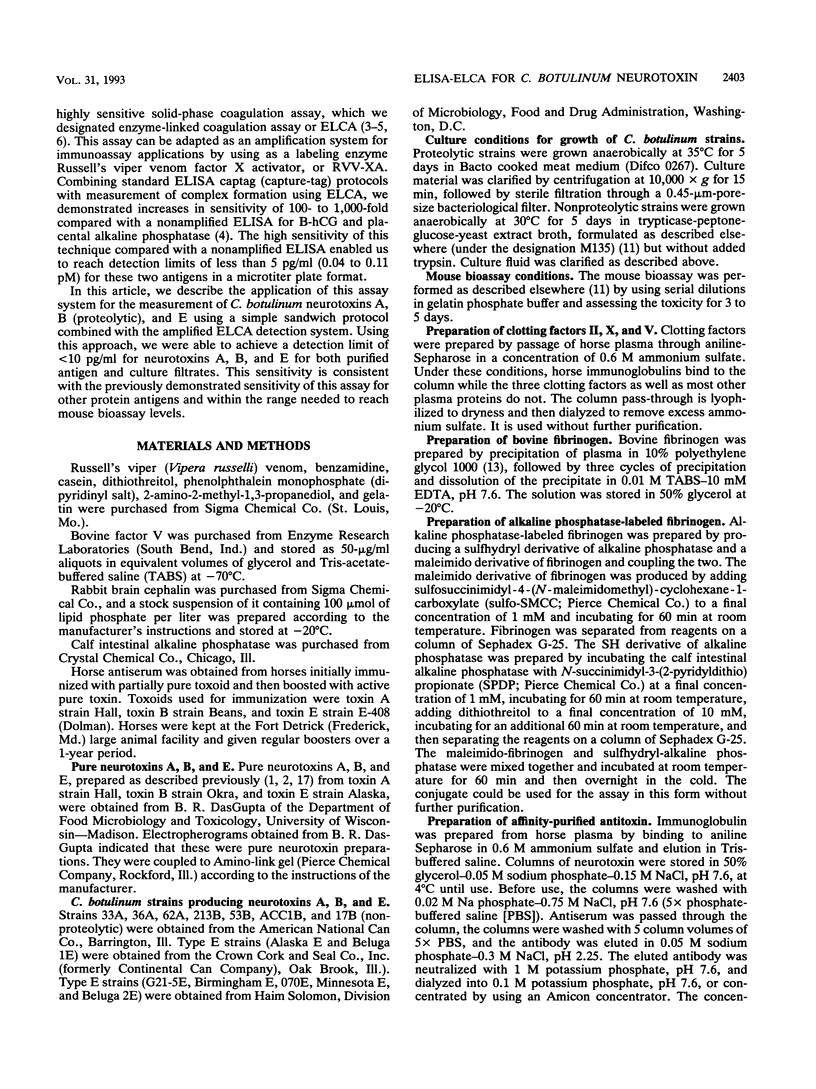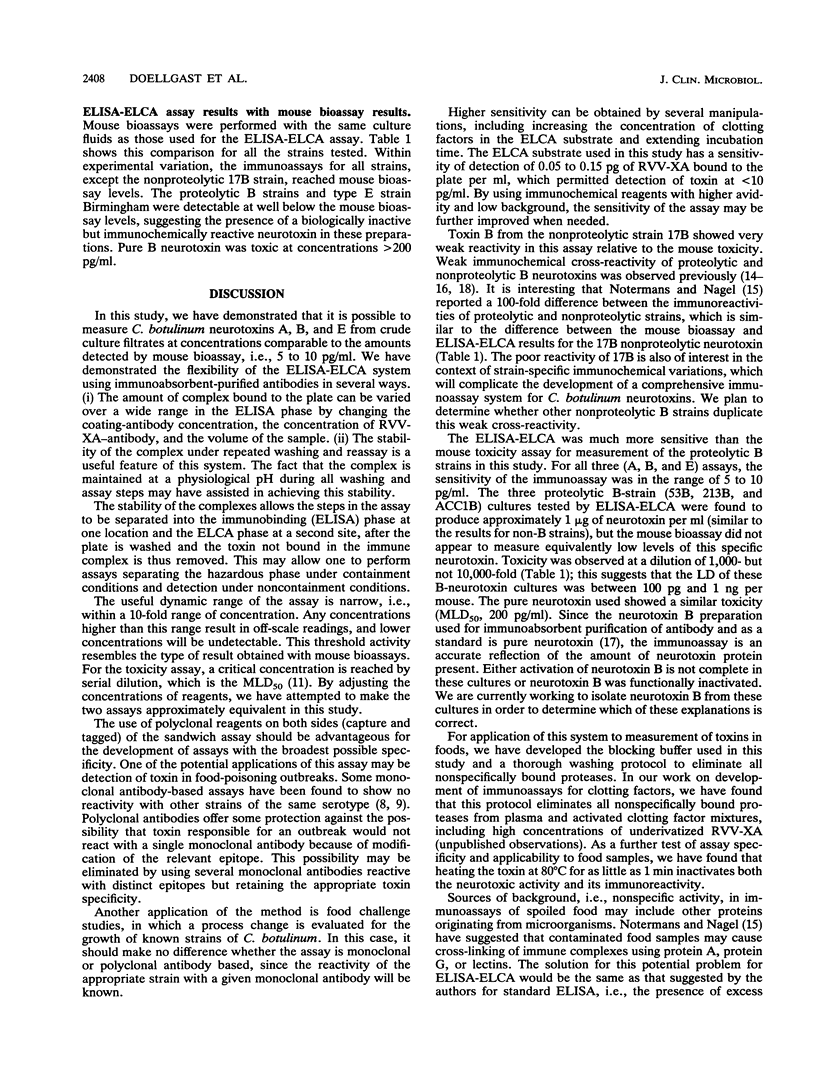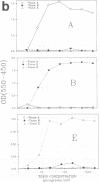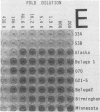Abstract
A new immunoassay amplification method has been applied to the measurement of toxins A, B, and E from Clostridium botulinum. The technique is a modified enzyme-linked immunosorbent assay (ELISA) which relies on the detection of sandwich complexes on microtiter plates by a solid-phase coagulation assay known as ELCA, or enzyme-linked coagulation assay. In the method, a coagulation activating enzyme (RVV-XA) isolated from the venom of Russell's viper is conjugated to affinity-purified horse antibodies specific for toxin type A, B, or E. Plates are coated with affinity-purified antibodies, and standard captag (capture-tag) protocols using labeled antibody are employed to bind the toxin from solution. Complexes are detected by adding a modified plasma substrate which contains all the coagulation factors mixed with alkaline phosphatase-labeled fibrinogen and solid-phase fibrinogen; deposition of solid-phase, enzyme-labeled fibrin on the solid phase is then a reflection of formation of toxin-RVV-XA-antibody complexes on the solid phase. Because of the ability to detect RVV-XA by this coagulation assay at concentrations < 0.1 pg/ml, it was possible to measure C. botulinum toxins A, B, and E at mouse bioassay levels (< 10 pg/ml, or < 0.07 pM) for both purified neurotoxin and crude culture filtrates obtained from strains known to produce appropriate single toxins. ELISA-ELCA should be applicable to measurement of toxins in most of the materials (contaminated food, blood, and excreta) for which the comparably sensitive mouse bioassay is currently employed. This method has the potential of broad application to the measurement of low concentrations of any antigen for which appropriate immunochemical reagents are available, in a color test format.
Full text
PDF







Images in this article
Selected References
These references are in PubMed. This may not be the complete list of references from this article.
- DasGupta B. R., Rasmussen S. Purification and amino acid composition of type E botulinum neurotoxin. Toxicon. 1983;21(4):535–545. doi: 10.1016/0041-0101(83)90131-9. [DOI] [PubMed] [Google Scholar]
- DasGupta B. R., Sathyamoorthy V. Purification and amino acid composition of type A botulinum neurotoxin. Toxicon. 1984;22(3):415–424. doi: 10.1016/0041-0101(84)90085-0. [DOI] [PubMed] [Google Scholar]
- Doellgast G. J. Enzyme-linked coagulation assay. III. Sensitive immunoassays for clotting factors II, VII, and X. Anal Biochem. 1987 Apr;162(1):102–114. doi: 10.1016/0003-2697(87)90014-5. [DOI] [PubMed] [Google Scholar]
- Doellgast G. J. Enzyme-linked coagulation assay. IV. Sensitive sandwich enzyme-linked immunosorbent assays using Russell's viper venom factor X activator-antibody conjugates. Anal Biochem. 1987 Nov 15;167(1):97–105. doi: 10.1016/0003-2697(87)90137-0. [DOI] [PubMed] [Google Scholar]
- Doellgast G. J., Rothberger H. Enzyme-linked coagulation assay: a clot-based, solid-phase assay for thrombin. Anal Biochem. 1985 Jun;147(2):529–534. doi: 10.1016/0003-2697(85)90310-0. [DOI] [PubMed] [Google Scholar]
- Durkee K. H., Cheng T. M., Doellgast G. J. Enzyme-linked coagulation assay: V. Amplified blotting assays using snake venom conjugates. Anal Biochem. 1990 Feb 1;184(2):375–380. doi: 10.1016/0003-2697(90)90696-7. [DOI] [PubMed] [Google Scholar]
- Ferreira J. L., Hamdy M. K., Herd Z. L., McCay S. G., Zapatka F. A. Monoclonal antibody for the detection of Clostridium botulinum type A toxin. Mol Cell Probes. 1987 Dec;1(4):337–345. doi: 10.1016/0890-8508(87)90015-6. [DOI] [PubMed] [Google Scholar]
- Gibson A. M., Modi N. K., Roberts T. A., Hambleton P., Melling J. Evaluation of a monoclonal antibody-based immunoassay for detecting type B Clostridium botulinum toxin produced in pure culture and an inoculated model cured meat system. J Appl Bacteriol. 1988 Apr;64(4):285–291. doi: 10.1111/j.1365-2672.1988.tb01873.x. [DOI] [PubMed] [Google Scholar]
- Gibson A. M., Modi N. K., Roberts T. A., Shone C. C., Hambleton P., Melling J. Evaluation of a monoclonal antibody-based immunoassay for detecting type A Clostridium botulinum toxin produced in pure culture and an inoculated model cured meat system. J Appl Bacteriol. 1987 Sep;63(3):217–226. doi: 10.1111/j.1365-2672.1987.tb04939.x. [DOI] [PubMed] [Google Scholar]
- Hutchinson D. N. Foodborne botulism. BMJ. 1992 Aug 1;305(6848):264–265. doi: 10.1136/bmj.305.6848.264. [DOI] [PMC free article] [PubMed] [Google Scholar]
- Masri M. A., Masri S. A., Boyd N. D. Isolation o human fibrinogen of high purity and in high yield using polyethylene glycol 1000. Thromb Haemost. 1983 Apr 28;49(2):116–119. [PubMed] [Google Scholar]
- Notermans S., Kozaki S., Kamata Y., Sakaguchi G. Use of monoclonal antibodies in enzyme linked immunosorbent assay (ELISA) for detection of botulinum type B toxins. Jpn J Med Sci Biol. 1984 Jun;37(3):137–140. doi: 10.7883/yoken1952.37.137. [DOI] [PubMed] [Google Scholar]
- Rymkiewicz D., Sawicki J., Brühl A. Study on the immunological heterogeneity of Clostridium botulinum B type toxin. Arch Immunol Ther Exp (Warsz) 1979;27(5):709–714. [PubMed] [Google Scholar]
- Sathyamoorthy V., DasGupta B. R. Separation, purification, partial characterization and comparison of the heavy and light chains of botulinum neurotoxin types A, B, and E. J Biol Chem. 1985 Sep 5;260(19):10461–10466. [PubMed] [Google Scholar]
- Shimizu T., Kondo H. Immunological difference between the toxin of a progeolytic strain and that of a nonproteolytic strain of Clostridium botulinum type B. Jpn J Med Sci Biol. 1973 Dec;26(5):269–271. doi: 10.7883/yoken1952.26.269. [DOI] [PubMed] [Google Scholar]
- Shone C., Wilton-Smith P., Appleton N., Hambleton P., Modi N., Gatley S., Melling J. Monoclonal antibody-based immunoassay for type A Clostridium botulinum toxin is comparable to the mouse bioassay. Appl Environ Microbiol. 1985 Jul;50(1):63–67. doi: 10.1128/aem.50.1.63-67.1985. [DOI] [PMC free article] [PubMed] [Google Scholar]







